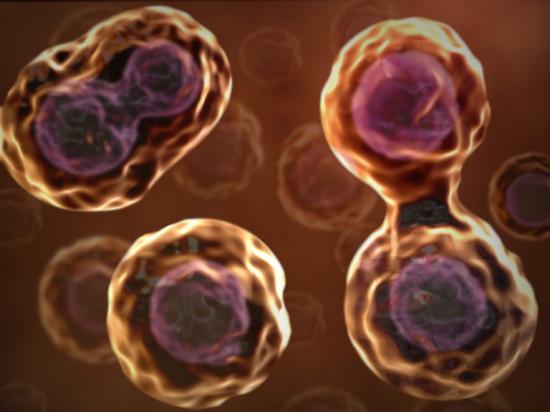摘要:氧气丰富时,细胞的生长很旺盛,缺少氧气时,细胞的生长就会停止。 虽然这个理论看似很简单,但是之前并没有发现细胞分裂与氧气水平之间存在着这样直接的联系。不过现在,约翰霍普金斯大学的研究人员发现:MCM蛋白能促进细胞分裂,也直接控制着氧气感应因子HIF-1蛋白。这项研究发表于6月10日的《分子细胞》。

Cell division
Gregg Semenza博士是迈克尔阿姆斯特朗的医学教授、霍普金斯医学研究所细胞工程项目主任以及McKusick-Nathans研究所的成员,他说:“这一直是个谜:为什么细胞中存在过量表达的MCM蛋白质。但现在我们发现这里面至少有一个原因,我们的数据表明, MCMs介导细胞分裂器和蛋白质之间的“对话,从而帮助细胞随着环境的不断变化做出相应的反应。”
生物探索推荐英文原文:
Johns Hopkins researchers link cell division and oxygen levels
Cells grow abundant when oxygen is available, and generally stop when it is scarce. Although this seems straightforward, no direct link ever has been established between the cellular machinery that senses oxygen and that which controls cell division. Now, in the June 10 issue of Molecular Cell, researchers at Johns Hopkins report that the MCM proteins, which promote cell division, also directly control the oxygen-sensing HIF-1 protein. "It's always been a mystery why a vast excess of MCM proteins is present in cells, but now we have discovered at least one reason," says Gregg Semenza, M.D., Ph.D., the C. Michael Armstrong Professor of Medicine, director of the vascular program in Hopkins' Institute for Cell Engineering and a member of the McKusick-Nathans Institute of Genetic Medicine. "Our data indicate that MCMs mediate crosstalk between the cell division machinery and proteins that help cells react to changes in their surroundings."
Since discovering HIF-1 in the 1990s, Semenza's team has been studying how it works to sense oxygen levels and turn on genes that help cells survive when oxygen is low. To find proteins that HIF-1 physically interacts with, the team went on a biochemical fishing expedition and, using HIF-1 as bait, pulled out MCM7. MCM7 is a member of a larger group of related proteins that are known to bind to DNA and start its duplication when a cell gets ready to divide. Using a different protein-binding technique, the team then found that HIF-1 also binds to MCM3.
When it senses low oxygen levels, HIF-1 turns on genes that enable cells to adapt, such as genes that stimulate the growth of new blood vessels and genes that alter a cell's metabolism to change how much oxygen it consumes for energy generation. To understand what MCM proteins do to or with HIF-1, the researchers examined how well HIF-1 turns on genes in the presence and absence of MCM3 or 7. They found when the levels of MCM proteins were increased, the activity of HIF-1 went down, while reducing the levels of MCMs, led to increased HIF-1 activity. "HIF-1 instructs cells not to divide, since more cells will consume more oxygen, making any shortage of oxygen even worse, while the role of MCMs is to trigger cell division" says Semenza. "So it's not surprising that MCMs would oppose the action of HIF-1."
The team also noticed that there seemed to be less MCM7 present when cells were exposed to low oxygen for 24 hours. To see if this had anything to do with HIF-1, they first turned up HIF-1 levels in cells--by either exposing them to low oxygen or treating them with a drug that boosts HIF-1 production--and found a decrease in the levels of MCM proteins 24 hours later. Separately, they removed HIF-1 from cells, then exposed the cells to low oxygen and found no change in MCM protein levels, allowing the group to conclude that HIF-1 controls MCM proteins as well, so that the MCMs and HIF-1 oppose each other's action. "It's like a tug of war," says Semenza. "When oxygen and nutrients are plentiful, MCMs win, and cells divide. When oxygen is low, HIF-1 wins and cell division is prevented. The mutual antagonism may be critical for tightly controlling cell growth based on oxygen availability."







